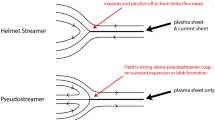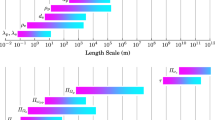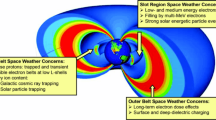Abstract
Solar type II radio bursts are interpreted as the radio signature of shock waves travelling through the solar corona. Some of these shock waves are able to enter into the interplanetary medium and are observed as interplanetary type II bursts. The nonthermal radio emission of these bursts indicates that electrons are accelerated up to superthermal and/or relativistic velocities at the corresponding shocks. Plasma wave measurements at interplanetary shock waves support the assumption that the fundamental type II radio emission is generated by wave-wave interactions of electron plasma waves and ion acoustic waves and that the source region is located near the transition region of the shock. Therefore, the instantaneous bandwidth of type II bursts should reflect the density jump across the shock. Comparing the theoretically predicted density jump of coronal shock waves (Rankine-Hugoniot relations) and the measured instantaneous bandwidth of solar type II radio bursts it is appropriate to assume that these bursts are generated by weak supercritical quasi-parallel shock waves. Two different mechanisms for the accelaration of electrons at this kind of shock waves are investigated in the form of test particle calculations in given magnetic and electric fields. These fields have been extracted from in-situ measurements at the quasi-parallel region at Earth’s bow shock, which showed large amplitude magnetic field fluctuations (so-called SLAMS: Short Large Amplitude Magnetic Field Structures) as constituent parts. The first mechanism treats these structures as strong magnetic mirrors, at which charged particles are reflected and accelerated. Thus, thermal electrons gain energy due to multiple reflections between two approaching SLAMS. The second mechanism shows that it is possible to accelerate electrons inside a single SLAMS due to a noncoplanar component of the magnetic field in these structures. Both mechanism are described in the form of test particle calculations, which are supplemented by calculations according to adiabatic theory. The results are discussed for circumstances in the solar corona and in interplanetary space.
Similar content being viewed by others
References
E. N. Parker,Astroph. J.,133, 1014 (1961).
Y. Uchida,Publ. Astron. Soc. Japan,12, 376 (1960).
A. Boischot, A. C. Riddle, J. B. Pearce, and J. W. Warwick,Sol. Phys.,65, 397 (1980).
V. L. Ginzburg and V. V. Zheleznyakov,Astron. Zh.,35, 694 (1958); (Sov. Astron.,2, 653 (1958)).
A. Krüger,Introduction to Solar Radioastronomy and Radio Physics, Reidel, Dordrecht (1979).
D. B. Melrose,Sp. Sci. Rev.,26, 3 (1980).
G. A. Newkirk,Astroph. J.,133, 983 (1961).
V. V. Zaitsev, E. Ya. Zlotnik, G. Mann, H. Aurass, and A. Klassen,Izv. Vyssh. Uchebn. Zaved., Radiofiz.,41, 164 (1998).
H. V. Cane, R. G. Stone, J. Fainberg, R. T. Stewart, J. L. Steinberg, and S. Hoang,Geophys. Res. Lett.,8, 1285 (1981).
Bothmer V. Private communication (1997).
G. Mann, H.-T. Claßen, and H. Aurass,Astron. Astrophys.,295, 775 (1995).
E. Priest,Solar Magnetohydrodynamics, Reidel, Dordrecht (1982).
A. R. Kantrowitz and H. E. Petschek, “MHD characteristics and shock waves,” in:Plasma Physics in Theory and Application (W. B. Kunkel, ed.), McGraw-Hill, New York (1966).
J. P. Edmiston and C. F. Kennel,J. Plasma Phys.,32, 411 (1984).
M. M. Mellot, in:Collisionless Shocks in the Heliosphere: Reviews of Current Research (B. T. Tsurutaniand and R. G. Stone, eds.), Washington, DC: AGU GN-35, 131 (1985).
J. T. Gosling, M. F. Thomsen, S. J. Bame, W. C. Feldmann, G. Paschmann, and N. Sckopke,Geophys. Res. Lett.,9, 1333 (1982).
S. J. Schwartz, M. F. Thomson, and J. T. Gosling,J. Geophys. Res.,88, 2039 (1983).
E. W. Greenstadt, in:Collisionless Shocks in the Heliosphere Reviews of Current Research (B. T. Tsurutani and R. G. Stone, eds.), Washington DC: AGU GN-35, 169 (1985).
D. A. Gurnett, F. M. Neubauer, and R. Schwenn,J. Geophys. Res.,84, 541 (1979).
D. Lengyel-Frey, G. Thejappa, R. J. MacDowall, R. G. Stone, and J. L. Phillips,J. Geophys. Res.,102, 2611 (1997).
G. D. Holman and M. E. Pesses,Astrophys. J.,267, 837 (1983).
A. O. Benz and G. Thejappa,Astron. Astrophys.,202, 267 (1988).
M. M. Leroy and A. Mangeney,Ann. Geophys.,2(4), 449 (1984).
C. S. Wu,J. Geophys. Res.,89, 8857 (1984).
D. Lengyel-Frey D. and R. G. Stone,J. Geophys. Res.,94, 159 (1989).
G. Paschmann, N. Sckopke, S. J. Bame, J. R. Asbridge, J. T. Gosling, C. T. Russell, and E. W. Greenstadt,Geophys. Res. Lett.,6, 209 (1979).
M. M. Hoppe, C. T. Russell, L. A. Frank, T. E. Eastman, E. W. Greenstadt,J. Geophys. Res.,86, 4471 (1981).
E. W. Greenstadt, J. M. Green, G. T. Inouye, D. S. Colburn, J. H. Binseck, and E. P. Lyon,Cosmic Electrodyn.,1, 160 (1970).
S. J. Schwartz, R. L. Kessel, C. C. Brinca, L. J. C. Wolliscroft, M. W. Dunlop, C. J. Farrugia, and D. S. Hall,J. Geophys. Res.,93, 11295 (1988).
M. F. Thomsen, J. T. Gosling, S. J. Bame, and C. T. Russel,J. Geophys. Res.,95, 957 (1990).
S. J. Schwartz, D. Burgess, W. P. Wilkinson, R. L. Kessel, M. Dunlop, and H. Lühr,J. Geophys. Res.,97, 4209 (1992).
M. Scholer, in:Plasmaphysik im Sonnensystem (K.-H. Glassmeier and M. Scholer, eds.), BI Wissenschaftsverlag, Mannheim (1991), p. 77.
S. J. Schwartz and D. Burgess,Geophys. Res. Lett.,18, 373 (1991).
G. Mann, H. Lühr, and W. Baumjohann,J. Geophys. Res.,99, 13315 (1994).
L. D. Landau and E. M. Lifschitz,Lehrbuch der Theoretischen Physik. Band VIII, Elektrodynamik der Kontinua, Akademie-Verlag, Berlin (1985).
M. Scholer, M. Fujimoto, and H. Kucharek, ESA SP-346 (1992), 59.
C. F. Kennel, J. P. Edmiston, and H. Hada, in:Collisionless Shocks in the Heliosphere: A Tutorial Review (R. G. Stone and B. T. Tsurutani, eds.), Washington DC: AGU GN-34, 1 (1985).
F. Malare and J. Elaoufir,J. Geophys. Res.,96, 7641 (1991).
G. Mann,J. Plasma. Phys.,53, 109 (1995).
E. Fermi,Astrophys. J.,119, 1 (1954).
E. N. Parker,Phys. Rev.,109, 1328 (1958).
J. R. Jokipii,Astrophys. J.,143, 961 (1966).
D. J. McLean, K. V. Sheridan, R. T. Stewart, and J. P. Wild,Nature, No. 234, 140 (1971).
G. Gisler and D. Lemons,J. Geophys. Res.,95, 14925 (1990).
G. Mann and H.-T. Claßen,Astron. Astrophys.,304, 576 (1995).
T. G. Northrop,The Adiabatic Motion of Charged Particles, Wiley Interscience, New York (1963).
N. A. Krall and A. W. Trivelpiece,Principles of Plasma Physics, McGraw-Hill, New York (1986).
H.-T. Claßen and G. Mann,Astron. Astrophys.,322, 696 (1997).
M. Scholer,J. Geophys. Res.,98, 47 (1993).
H. Kucharek and M. Scholer,J. Geophys. Res.,96, 21195 (1991).
Additional information
Astrophysikalisches Institut, Observatorium für solare Radioastronomie, Potsdam, Germany. Published from Izvestiya Vysshikh Uchebnykh Zavedenii, Radiofizika, Vol. 41, No. 1, pp. 84–104, January, 1998.
Rights and permissions
About this article
Cite this article
Claßen, H.T., Mann, G. Electron acceleration and type II radio emission at quasi-parallel shock waves. Radiophys Quantum Electron 41, 53–67 (1998). https://doi.org/10.1007/BF02676712
Received:
Issue Date:
DOI: https://doi.org/10.1007/BF02676712




